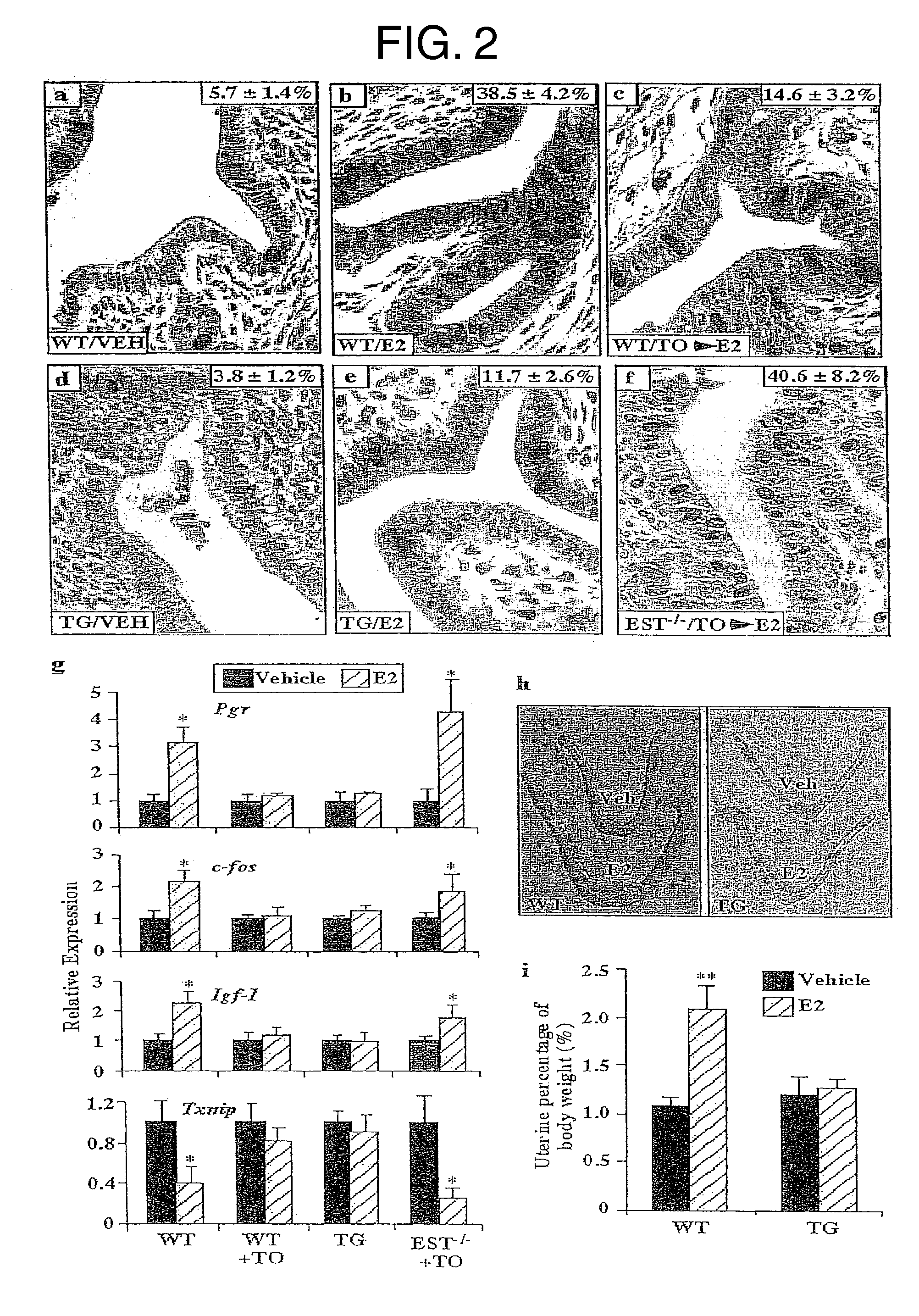Methods of treating estrogen-responsive conditions by orphan nuclear receptor activation
a technology of orphan nuclear receptor and treatment method, which is applied in the direction of antineoplastic agents, drug compositions, medical preparations, etc., can solve the problems of preventing a desired fertility outcome, increasing the risk of estrogen-responsive cancer, osteoporosis, and increasing the risk of heart disease, so as to reduce the size of an estrogen-responsive tumor and inhibit estrogen activity
- Summary
- Abstract
- Description
- Claims
- Application Information
AI Technical Summary
Benefits of technology
Problems solved by technology
Method used
Image
Examples
example 1
[0072] This example demonstrates that estrogen sulfotransferase (EST) is a transcriptional target of LXR, and that EST can be increased upon activation of LXR by administration of LXR agonists.
[0073] Transgenic mice, having a mixed background of C57BL / 6J and 129 / SvImJ, were created expressing activated LXRa in the liver under the control of the fatty acid binding protein (FABP) promoter. (FIG. 1) EST levels in liver cells of the transgenic mice were compared to wild-type mice using Northern blot analysis and real-time PCR, as described in Gong, H. et al. Mol. Endocrinol. 20:279-290 (2006) and Zhou, J. et al. J Biol Chem. 281: 15013-15020 (2006), respectively. In the transgenic mice expressing activated LXRα, the liver expression of EST was markedly up-regulated as compared to wild-type mice.
[0074] Wild-type mice were treated with LXR agonists TO1317 (T0901317) or 22(R)-hydroxycholesterol (FIG. 1a), and EST levels were compared to DMSO-treated control mice as described above. As in...
example 2
[0077] This example demonstrates the effect of LXR-mediated EST activation on estrogen deprivation.
[0078] Ovariectomized wild type and VP-LXRα transgenic females were subjected to uterine estrogen response measurements that include epithelial proliferation by BrdU labeling and estrogen responsive gene expression by real-time PCR. Five-week old virgin females were subjected to ovariectomies. Seven days after the surgery, mice were given a single s.c. injection of 17β-estradiol (E2) (25 μg / mouse). 18 h after the E2 injection, mice were given a single i.p. injection of bromodeoxyuridine (BrdU) (60 mg / kg) and sacrificed 2 h after. One uterine horn was harvested for histology and measurement of cell proliferation by BrdU immunostaining (Xie, W., et al., Mol. Endocrinol. 11: 1766-1781 (1997)) and the other was harvested for RNA extraction and gene expression analysis by real-time PCR. In the uterotropic bioassay, 3-week-old virgin female mice received daily s.c. injections of vehicle or ...
example 3
[0080] This example demonstrates the molecular mechanism by which LXR can be shown to regulate EST.
[0081] The 4.2-kb (−4164 bp to +46 bp) 5′ regulatory sequences of the mEst gene were cloned by PCR using a template of mEst-containing bacterial artificial chromosome (BAC) clone (ID RP24-571N6) from the Children's Hospital Oakland Research Institute BACPAC Resource Center (Oakland, Calif.). Deletion mutants were generated by PCR-mediated mutagenesis. HepG2 cells were transfected with the reporter constructs and LXRα expression vector in 48-well plates as previously described . Gong, H. et al., Mol. Endocrinol. 20:279-290 (2006) When necessary, cells were treated with TO1317 (10 μM) for 24 h prior to luciferase assay. The transfection efficiency was normalized against the β-gal activities from a co-transfected CMX-β gal vector. The hydrodynamic liver transfection was performed as we previously described. Zhou, J. et al. J Biol Chem. 281: 15013-15020 (2006). EMSA were performed using i...
PUM
| Property | Measurement | Unit |
|---|---|---|
| time | aaaaa | aaaaa |
| size | aaaaa | aaaaa |
| Northern blot | aaaaa | aaaaa |
Abstract
Description
Claims
Application Information
 Login to View More
Login to View More - R&D
- Intellectual Property
- Life Sciences
- Materials
- Tech Scout
- Unparalleled Data Quality
- Higher Quality Content
- 60% Fewer Hallucinations
Browse by: Latest US Patents, China's latest patents, Technical Efficacy Thesaurus, Application Domain, Technology Topic, Popular Technical Reports.
© 2025 PatSnap. All rights reserved.Legal|Privacy policy|Modern Slavery Act Transparency Statement|Sitemap|About US| Contact US: help@patsnap.com



